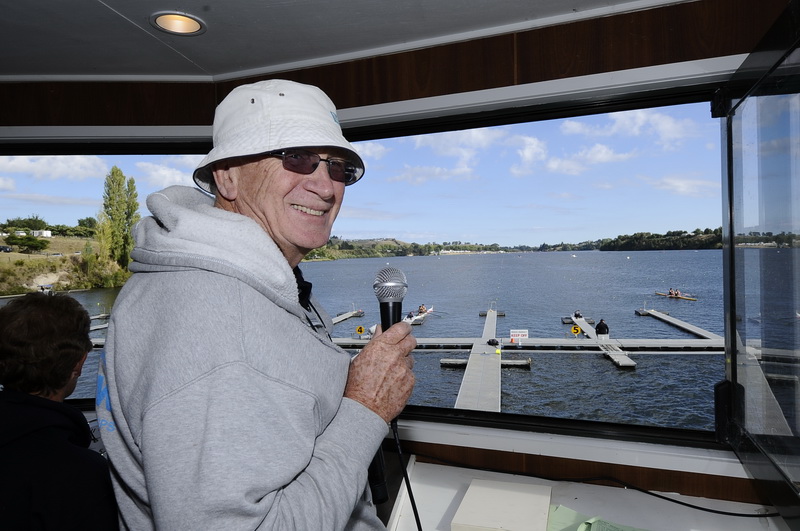A morning at the start line
Although pontoon access is usually limited to officials and helpers, photographer Geoff Ridder and reporter Libby Wilson from the Independent were allowed in to see what goes into sending off Maadi’s races.
Two kilometres from the finish, the atmosphere at the start line could not be more different.
Instead of cheering supporters, and colourful team tents, there is a network of pontoons and a crew of volunteers and officials.

We wind down a small gravel driveway which leads to the hill above the pontoons where rowers line up.
All the white minivans are nearer the finish, and there is just a handful of sedans parked on the grass.
We park by the portaloos and look over the network of floating metal pontoons.
Eight boats are held in place in their respective lanes while announcements are made over the PA system.
On the far side, the next race’s crews are holding place.
Photographer Geoff Ridder shoulders his 300mm telephoto lens and takes off down the goat track, so I follow.
Before we get off the semi-solid decking, Geoff checks in with the officials in the aligner’s hut, and they wave us through.
Out on the pontoons, it is deceptively peaceful – until I try walking, that is.
The metal flexes underfoot, and each step makes a racket.
Otherwise, the only sounds are water lapping against the pontoons, and a background drone of race announcements.
Each crew moves over to its lane, where it is received by a boat holder and helper.
One man tells me that many of them have been at the start line since seven o’clock, setting up speakers and lights.
Any late boats are located and called straight to their lane by the starters.
Geoff finds a spot where the sun is behind him, and lines up a shot of the closest crew.
I hear the aligner, Brian Clarke, start calling out any necessary boat placement adjustments, so I stay nearby and watch.
“One out… stop! Three back a touch. Stop.”
The boat holders adjust the length of the pontoons to suit the boat.
“Four out. Four out. Four out, please. With your hands. Stop. Hold it steady there.”
He checks his video screen – all the bows are on the red line, and they soon move off on the buzzer.
As I pass him on my way up to the starters’ tower, Geoff tells me he has just received a photo request from one of the other reporters.
I haven’t got a day sheet, so he sends one to my phone, and moves off to locate the crew.
When I get to the top of the tower steps, I find Michele Hawke in the starter’s seat, assisted by Murray Macdonald.
Murray says he has only been at the start line for ten years, so he is just an apprentice.
There is a lot of radio traffic to keep them busy, so I move onto the balcony, where I’m out of the way.
Murray reminds the waiting boats to stay back from the line, then comes out to check the big yellow and black letter on the tower balcony.
It represents the event, and matches what the boats in the race have on their bows.
Geoff spies us from down on the pontoons, and aims his camera in our direction.
A buzzer sounds, letting the starters know the alignment is complete.
They can see a white flag at the officials’ boat, so Michele begins.
“Timaru Boys’, New Plymouth, Rotorua, Nelson, Wanganui, St John’s Hamilton, Roncalli, St John’s Hastings: attention.”
The traffic lights facing each crew go red.
The starter pauses to check the course is clear, then pushes the buzzer.
The lights go green.
A stream of clicks come from Geoff’s camera.
Gentle lapping sounds are replaced by oars cutting through water, coxswains’ calls, and the umpires’ boat roaring into action.
By the time the boats are 30 metres away, one of the start crew has already rushed out to change the letter on the balcony.
Back inside, there is hardly a break in the radio chatter.
One crew is coming down early because they need to change a rower.
Safety boat one needs to check on another.
The aligner requests an announcement to some of the waiting crews – they are too close to the start line, and need to move back.
Three more boat-holders have arrived to ease the pressure on a team which is understaffed this morning, and snacks are distributed to the volunteers.
Geoff signals to me that now might be a good time to leave, so I call out a thank you and sneak back down the stairs.
We make a quick exit to avoid distracting the rowers in the next race.
By the time we make it back to the car, the buzzer has sounded, and they are off.
Then the next race is called, and the cycle continues.




